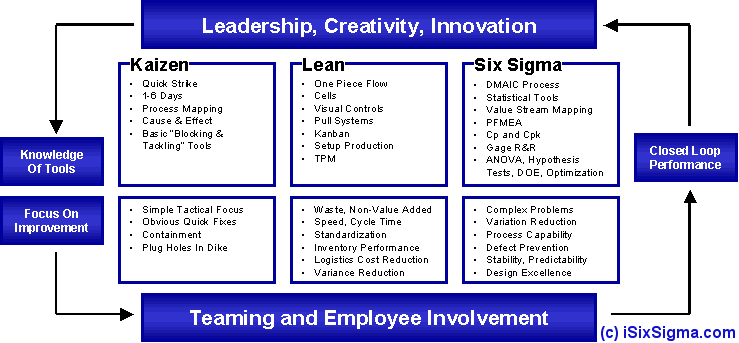
This is a familiar question that is often addressed by organizations. In fact, it is the wrong question. These concepts are nothing more than tools in your management toolbox. You don’t fix a watch with a hammer, and you get the same results when you deploy Six Sigma, Lean and Kaizen incorrectly. The fact is, a business problem is a business problem, and it needs to be fixed. Understanding the application of these tools to various improvement opportunities is the key to success. The figure below provides a perspective on how to integrate Six Sigma, Lean, and Kaizen into a total business improvement strategy.

People spend months drilling the Six Sigma process and statistical tools into their heads until they look at every situation as a Six Sigma problem. Why not? It was a very successful and rewarding experience for these individuals. But it is also easy to make mountains out of molehills. You don’t want the organization running around performing DOEs on the internal mail system or the quality of cafeteria food. On the other extreme, some high anxiety managers tend to look at very complex process variation or larger scale strategic problems as a Kaizen blitz that can be fixed by tomorrow. They are looking for instantaneous improvements in more complex areas such as variance reduction, customer returns, or forecast accuracy. For these situations, one question to reflect upon is “How long did it take us to get into this situation?”
The most important drivers of breakthrough improvement are leadership, creativity and innovation. Executives must lead and mentor their people in the right directions and assure that their actions are linked to strategic performance. They need to deploy limited resources to the highest impact areas and not try to solve every problem in the company. To accomplish this, they need to understand Six Sigma, Lean, Kaizen and other improvement methodologies, and how to integrate these tools into an overall business improvement strategy.
Refer to the framework in the figure above: Every strategic improvement initiative requires the following infrastructure shell:
Leadership, Creativity and Innovation
This element aligns strategy and deployment, mentors the organization through the right execution path, and drives cultural change. When the leadership team understands Six Sigma, Lean and Kaizen they can provide clearer focus on what needs to be done to improve profitability and competitiveness.
Teaming and Employee Involvement
This element provides the connection between concept and reality. People understand the need to change, they are equipped with the right tools and they are empowered to take action.
Closed-Loop Performance
This element pegs accountability and process ownership. Real-time performance measurement also allows people to better understand the cause-and-effect relationship between their actions and the improvement goals.
Some improvement opportunities are fruit on the ground or low hanging fruit, and can be harvested through several quick-strike Kaizen blitz efforts. These are the obvious localized no-brainers that we trip over everyday. The solution is not rocket science. It is simplicity, action and common sense.
As you move from left to right in the figure above, the scope and complexity of the improvement opportunity increases, but so do the potential benefits. Lean manufacturing typically focuses on speed, elimination of waste, standardization, and flexibility/responsiveness. Most Lean efforts begin on the production floor, however, the philosophy and tools are equally applicable in soft process areas such as new product development, distribution/logistics, supply chain management, accounting/finance and customer service.
On the right side of the above figure is Six Sigma. These are the highest impact opportunities because we are deep core drilling into the hidden cost of poor quality (COPQ). Making a dent in these areas often results in cost reductions of 2 percent-7 percent of annual revenues for successful organizations. Six Sigma is a data-driven methodology that strives for perfection in the organization’s entire value chain. Six Sigma examines variation and root causes of current performance, with a focus not only on the production floor, but on all key business processes. With Six Sigma, the entire organization is placed under the microscope. The methodology and statistical tools provide structure, discipline and a logical progression for achieving breakthrough improvements.
For more than a decade, publications such as Fortune, Business Week and hundreds of books have stressed the human side of change, infrastructure, customer focus, boundaryless and learning organizations, innovation and out-of-box thinking, and cultural transformation. Executives continue to send their employees off to Six Sigma, Lean or Kaizen boot camps to learn the tools, but they are often disappointed with the lack of results. Executives who develop a working knowledge of Six Sigma, Lean and Kaizen are much better prepared to build the right infrastructure and lead their organizations to both financial and human success.